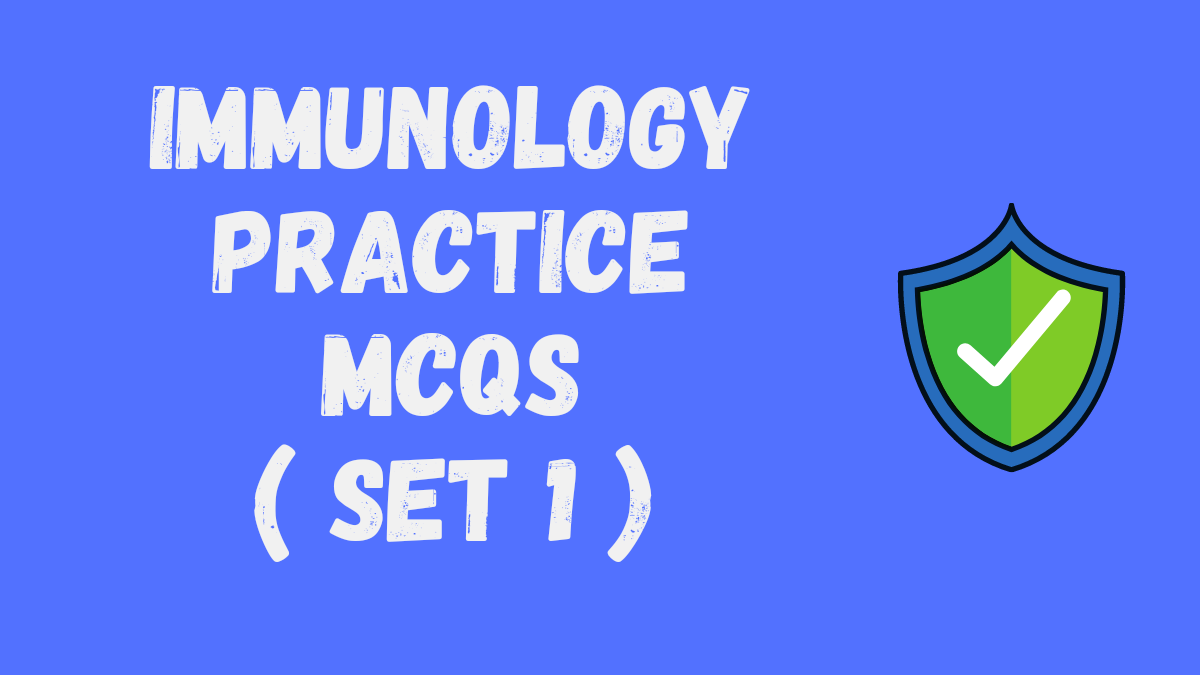Immunology Practice MCQs (Set 1)
Below are Immunology Practice MCQs ( Set 1).
1. Which of the following features is not shared between ‘T cells’ and ‘B cells’?
a) Antigen Specific Receptors
b) Class I MHC Expression
c) Positive selection during development
d) All of the above
2. CD4 is not important for which of the following?
a) Antibody production
b) Cytotoxicity of T cells
c) Memory B cells
d) Opsonization
e) None
3. Type 1 MHC presents peptide antigen to T cell, so that peptide binding site is formed by?
a) Alfa and Beta chain
b) Distal domain alfa 1 and 2
c) Alfa and Beta microglobulin
d) Proximal domain alfa 1 and 2
4. Function of CD4 is all except:
a) Memory
b) Immunoglobulin production
c) Activation of macrophages
d) Cytotoxicity
5. A superantigen is a bacterial product that
a) Binds to B7 and CD28 costimulatory molecules
b) Binds to the beta chain of TCR and MHC class II molecules of APC stimulating T cell activation
c) Binds to the CD4+ molecule causing T cell activation
d) Is presented by macrophages to a larger than normal number of T helper CD4+ lymphocytes
6. Memory T cells can be identified by using the following marker:
a) CD45RA
b) CD45RB
c) CD45RC
d) CD45RO
7. All of the following statements about NK cells are true except:
a) They are derived from large granular cells
b) They comprise about 5% of human peripheral lymphoid cells
c) They are MHC restricted cytotoxic cells
d) They express IgG Fc receptors
Answers :
1) C 2) E 3) B 4) B 5) B 6) D 7) C
8. The following feature is common to both cytotoxic Tcells and NK cells:
a) Synthesize antibody
b) Require antibodies to be present for action
c) Effective against virus infected cells
d) Recognize antigen in association with HLA class II markers
9. MHC restriction to antigen presentation is not done for:
a) Killing of viruses by cytotoxic cells
b) Killing of bacteria by helper cells
c) T cell activation in autoimmunity
d) Graft rejection
10. Most potent stimulator of naïve T cell is:
a) Mature dendritic cell
b) Follicular dendritic cell
c) Macrophages
d) B cell
11. Natural killer cells attacks which of the following cells:
a) Cells which express MHC1
b) Cells which are not able to express MHC1
c) MHC cells which express MHC2
d) Cells which are not able to express MHC
12. Toll like receptors, recognize bacterial products and stimulates immune response by:
a) Perforin and granzyme mediated apoptosis
b) FADD ligand apoptosis
c) Transcription of nuclear factor mediated by NFxB which recruits cytokines
d) Cyclin
13. The following interleukin is characteristically produced in a TH1 response:
a) IL2
b) IL4
c) IL5
d) IL10
14. CD95 has a major role in:
a) Apoptosis
b) Cell necrosis
c) Interferon activation
d) Proteolysis
Answers:
8) C 9) D 10) A 11) B 12) C 13) A 14) A
15. Which of the following chemical mediators of inflammation is an example of a CXC or alpha Chemokine?
a) Lipoxin LXA4
b) Interleukin IL8
c) Interleukin IL6
d) Monocyte Chemoattractant protein MCP1
16. The complement is fixed best by which of the following immunoglobulins:
a) IgG
b) IgM
c) IgA
d) IgD
17. Antigen presenting cells are which of the following:
a) Astrocytes
b) Endothelial cells
c) Epithelial cells
d) Langerhan’s cells
18. Antigen presenting cells are:
a) Langerhan’s cell
b) Macrophage
c) Cytotoxic T cells
d) Helper T cells
e) B lymphocyte
19. Perforins are produced by:
a) Cytotoxic T cells
b) Suppressor T cells
c) Memory helper T cells
d) Plasma cells
e) NK cells
20. Cell surface molecules involved in peripheral tolerance induction are:
a) B7 and CD28
b) CD40 and CD40L
c) CD34 and CD51
d) B7 and CD3
21. Marker for B Lymphocyte:
a) CD34
b) CD33
c) CD19
d) CD20
e) CD22
Answers:
15) B 16) B 17) BCD 18) A BE 19) A 20) A 21) CDE
23. Antigen presenting cells present in skin are called
a) Langerhan’s cells
b) Kupffer’s cells
c) Microglia
d) Melanocytes
24. Plasma cells
a) Contain nucleus
b) Helps in the formation of antibody
c) Are deficient in cytoplasm
d) Are derived from T cells
25. The normal ratio of CD4 to CD8 is
a) 1:1
b) 2:1
c) 8:1
d) 10:1
26. CD4 cells is used to identify which of the following
a) MHC I
b) MHC II
c) T cells
d) B cells
27. CD3 is marker for:
a) Monocyte
b) T cell
c) B cell
d) None
28. Which of the following is not true about innate immunity?
a) It is present prior to antigenic exposure
b) It is relatively nonspecific
c) Memory is seen
d) It is the first line of defence
29. Which one of the listed receptors is the type of receptor on leukocytes that binds to pathogen-associated molecular patterns (PAMPs) and mediates immune response to bacterial lipopolysaccharide?
a) Cytokine
b) Receptor
c) Gproteincoupled receptor
d) Mannose receptor
e) Tolllikereceptor
Answers
23) A 24) B 25) B 26) C 27) B 28) C 29) D
30. Immunity against cancer cells:
a) Basophils
b) Eosinophils
c) NK cells
d) Neutrophils
31. NK cell express:
a) CD15, CD55
b) CD16, CD56
c) CD16, CD57
d) CD21, CD66
32. NK cell CD marker is:
a) 16
b) 60
c) 32
d) 25
33. The following interleukin is characteristically produced in a TH1 response?
a) IL2
b) IL4
c) IL5
d) IL10
34. Most potent stimulator of Naïve Tcells:
a) Mature dendritic cells
b) Follicular dendritic cells
c) Macrophages
d) B cell
35. Which of the following immune cells have the expression of CD8 on their surface?
a) Tcells
b) Bcells
c) Null cells
d) Macrophages
36. Kupffer cells are found in:
a) Heart
b) Lungs
c) Liver
d) Spleen
Answers:
30) C 31) B 32) A 33) A 34) A 35) A 36) C

